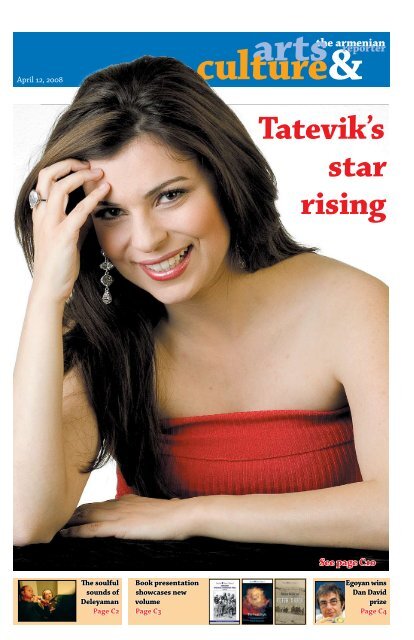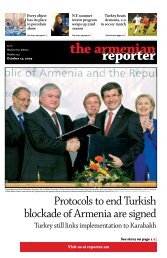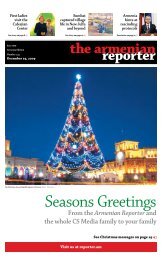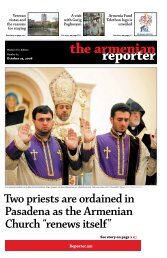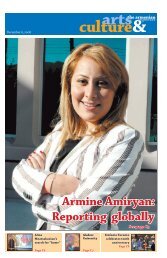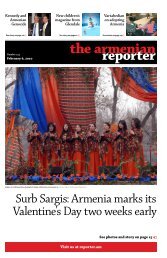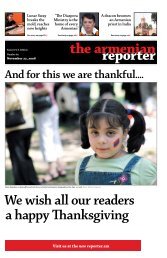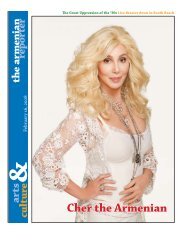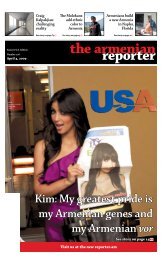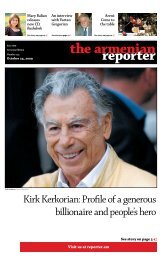Arts & Culture - Armenian Reporter
Arts & Culture - Armenian Reporter
Arts & Culture - Armenian Reporter
You also want an ePaper? Increase the reach of your titles
YUMPU automatically turns print PDFs into web optimized ePapers that Google loves.
the armenianreporterApril 12, 2008April 12, 2008culture&artsthe armenian reporter&Tatevik’sstarrisingThe soulfulsounds ofDeleyamanPage C2Book presentationshowcases newvolumePage C3See page C10Egoyan winsDan DavidprizePage C4
The soulful sounds of DeleyamanLos Angeles debut May 2by MarinaTerteryanThe music of Deleyaman is what the UnitedNations might sound like if its membershappened to be talented musicians anddecided to form a band. The four membersare of American-<strong>Armenian</strong>, French-<strong>Armenian</strong>, French and Swedish descentsand use lyrics and instruments from theirrespective countries. Their songs are melodicand soulful, every note and wordpacked with deep emotion. The groupconsists of singer/songwriter/producerAret Madilian, singer/songwriter BeatriceValantin, drummer Mia Bjorlingsson andduduk player Gerard Madilian.To add to their diversity, fans of thegroup range anywhere from <strong>Armenian</strong>grandmothers to listeners of gothic music,to psychologists at a convention.Though it may be an odd combination oflisteners, hearing their music explainsexactly why such unrelated groups ofpeople could enjoy it. The best way to describeDeleyaman’s sound is a dark, harmoniousand sacred vibe that combinessmooth, choral-influenced vocals withthe mourning sounds of the duduk.Each member’s unique backgroundand contribution is clearly showcasedthroughout their songs: Aret and Gerard’s<strong>Armenian</strong> heritage, Beatrice’schoral background and Mia’s rhythmicfeel. In fact, the influence of all factorsof their lives can be heard throughouttheir music. For one, the members alllive and record in Normandy, France; aserene seaside town surrounded by nature,and that sense of peacefulness ispresent in their music.“What brings us together are…ourpaths that have strangely yet naturallycrossed in a foreign land and our mutualattraction to a certain form of music.[Also] a deep belief about existence, theway we talk about our beliefs, philosophies–those conversations are importantfor us,” said Aret. “We have something incommon–all four of us are still searching.We are not old enough to be wise but notyoung enough to be still dreaming.”Aret, Beatrice, and Gerard met in 2000.They started recording together almostimmediately and completed their firstalbum by July of the following year.Starting with a set of songs that Arethad composed, they each added their respectiveelements of vocals and duduk.Knowing they would need a drummer forlive performances, the three approacheddrummer Mia Bjorlingsson, a Swedishdrum teacher who also lived in Normandy.Soon after, they signed an agreement<strong>Armenian</strong> <strong>Reporter</strong> <strong>Arts</strong> & <strong>Culture</strong>Copyright © 2008 by <strong>Armenian</strong> <strong>Reporter</strong> llcAll Rights ReservedContact arts@reporter.am with announcementsTo advertise, write business@reporter.am or call 1-201-226-1995Gerard Madilian and Aret Madilian.with a French independent record labelcalled NECH, for duplicating and promotingtheir CDs, and another label namedTTO Records, for album distribution andfinancial support for concerts.“We wanted to keep the creative processas independent as possible,” saidAret on why they chose to record theiralbums themselves in his home studio,without the involvement of a record label.“Keeping control over our recordingsgave us the possibility of creatingour own sound and atmosphere.” Thegroup happens to be very serious abouttheir craft. Though they enjoy the processesof making music, they also take avery professional approach for the successof the group.“This isn’t just a way of passing time,it’s a serious activity that gives sense toour lives,” said Aret. He explained theyare very punctual when it comes timeto practice and determined to make themost of the time they have. When theband was first formed, they realizedthey would need some substantial practicein performing in front of an audienceas a group before they could branchout to promotional concerts. So they begana series of public dress rehearsals ina small neighborhood venue called “LaMenuiserie,” inviting their friends andfamily to attend.“We wanted to rid ourselves of thepressure of performing in public,” saidAret. “Pretending you’re playing in publicduring practice is very different fromactually performing in front of people.It automatically gave us the pressure totighten up and play better during concerts.”The first Deleyaman performanceas a band was at the 2002 <strong>Armenian</strong> MusicAwards at the Alex Theatre in Glendale,California.Aret, whose compositions made upmost of the first album titled 00/1, grewup in Los Angeles and was constantlyinvolved in music. Part of the “generationof punk bands at the time whenwe didn’t give it names, we just playedmusic,” he says describing one of hisearliest band projects which won a localcontest sponsored by the famous radiostation KROQ FM.He moved to Europe in his 20s to pursuea distribution deal for that projectwith a Dutch record label. When thatdidn’t work out, he moved back to LosBeatrice Valantin.Angeles and challenged himself to recordan album of acoustic piano compositions,something different fromthe electronic instruments he was usedto. The result was two albums, Mask, in1996 and Illusion, in 1998 released underStepan Partamian’s then-young recordlabel Garni/Diaspora. Moving back toFrance in 2000, he formed Deleyaman.The group has since released three fulllengthalbums: 00/1 in 2001, Second in2003 and 3 in 2006.Gerard and Beatrice encouraged Aretto integrate <strong>Armenian</strong> words and melodiesinto their music. The first song theyrecorded together was Deleyaman, writtenby Aret and named after the famous<strong>Armenian</strong> folk song, which Beatrice immediatelyfell in love with.“I asked him the meaning and he toldme about the story of the song…thewords Dele Yaman are like a calling inthe story – exactly the meaning of whatwe want to do in our music,” she said.On page C1: Fresno DJ Tatevik Ekezian counts down the hits on Horizon TV.See story on page C10.So the name stayed, along with heavyinfluences of <strong>Armenian</strong> words, poetry,melodies and history.“It’s not difficult to sing in <strong>Armenian</strong>.In the beginning it was very strange becauseit was far away from French butnow it’s very familiar for me,” Beatricesaid. As the female vocalist in the group,she draws on her extensive choral trainingfrom her early involvement in music,which is immediately felt in her stackedharmonies and ethereal melodies.“[As a child] I used to go to church everySunday, all day long,” she explained.Getting bored of waiting for her turn tosing, she regularly went to her parents’sections in the choir and “learned theirparts of the hymns. That’s how I learnedharmony, and why I’m so sensitive toit.” Beatrice’s creativity also stretchesto visual media. Aside from her choralbackground, she comes from an artisticfamily and incorporates her interestin painting, photography and film intothe band’s endeavors. She creates thealbum artwork, posters and images theyproject onto the stage during live shows,which she calls “dreaming videos.”Gerard, who has been playing theduduk since he was 12 years old, waspreviously involved in several projects,including performing in a duduk-dholduo, a two-duduk and dhol trio and creatinga dance company called Les BalletsArmeniens. Mia, studied music in highschool and later at the J. Dalcroze Instituteof Ryhthm in Brussels, Belgium.She performed bass guitar with an allgirlgroup before joining Deleyaman.In April 2007, the group was invitedto perform several shows in Armenia bythe Naregatsi Art Institute, a nonprofitphilanthropic organization that promotes<strong>Armenian</strong> arts and culture. Theyperformed at the inauguration of theNaregatsi Art Institute Center in Shushi,Karabakh, an April 24 commemorationevent at the American University of Armeniaand a series of shows in villagessuch as Goris, Alaverdi, and Gyumri.Though it was his first time in Armenia,the Istanbul-born and American-raisedAret immediately felt at home due tothe warm and receptive atmosphere. Atone show in Alaverdi, he recalled thataudience members saw their van arriveand rushed to help them unload theirinstruments. Beatrice had no troublefeeling at home, either.”Armenia was a great experience for me.I felt like I was in my own family- theywelcomed me so well, as a sister,” she said.That has led to other international performances,including a series of upcomingshows in the Los Angeles Area in May, producedby the Naregatsi Art Institute andTTO Records. Aret explained the group islooking forward to these and other performancesand later working on a new albumto be released in 2009, which will explorenew musical directions for them.“We are still young as a band - we have alot of creative paths to explore, a lot to saymusically,” he said. “My goal is to continueto explore ourselves, to continue to dig intowho we are, all the while doing music.” fconnect:deleyaman.comC2 <strong>Armenian</strong> <strong>Reporter</strong> <strong>Arts</strong> & <strong>Culture</strong> April 12, 2008
Daniel Varoujan’s poems still burnby LoryBedikianI have been thinking of Daniel Varoujanand the images he carves into his verse.In the poetry of Varoujan, objects cometo life, movement occurs in every line andcolors bleed upon the page. His poemsare sometimes written on injustices andin other instances bring about a veiledsensuality and earthiness.Like so many other poets and intellectuals,Daniel Varoujan’s life was cutshort—at the age of 31—in 1915. As ateacher and poet he must not only havechanged lives, but changed the way peoplelooked at life through his stunningwords, through his several collections ofpoems.Varoujan is a master at braiding togetherverbs that awaken our sensesand colors that adorn the palette of hispoems, such as in “Ripe.”RipeMy field is burnished gold.It turns and churns;without firemy wheatfield burns.Lory Bedikian received her MFA in Poetry from theUniversity of Oregon. Her collection of poetry hasbeen selected as a finalist in both the Crab OrchardSeries in Poetry Open Competition and the Crab OrchardSeries in Poetry First Book Award Competition.My field is honeygold.The edge of day melts downto fill its honeycombin coils of brown.My field is ambergold.Rows of corncatch yellow butterflieswith nets of sun.My field’s a golden nestfor swallow wings at rest,for bumblebee and wasp,a hive about to burst.As the poem “turns” from one lineto the next, the reader is immersed in“gold,” “brown,” “ambergold,” or “yellow.”The poem has an exquisite relentlessnessin how it redresses the speaker’s“field,” and Varoujan revises the scene ofthe field over and over just like a painter,at the canvas of a landscape, who sweepsbrushstrokes, one on top of the otheruntil it’s just right. And what bringsthe poem to life – besides the creaturesmentioned – is the use of verbs suchas “churns,” “melts,” or “catch.” And, ofcourse, closing with the image of “a hiveabout to burst,” the reader feels the potentialexplosiveness of the speaker’semotions. The extended metaphor ofthe field strategically guides us to thisfeeling at the close of the lyric. His“wheatfield burns” “without fire,” butdoes so with color and intensity.Those who know and admire Varoujan’swork have read and reread “The Lamp,” apoem within which a moment of reliefand joy is reversed for the speaker.The LampFill oil into the lamp, dear daughter.Trim its wick, Hars, so we can go.I hear the wagon turn into the yard.I hear the wheels stop beside the well.Hurry, Hars. Our soldier is home now.My boy is back with us. He’s home.Light the lamp so we can see the hero’slaurel on his brow.Light it, Hars. Hold it high.Wait. What is that blood in the wagon?Who is that lying pale and still?Put out the lamp, Hars. Put out the light.The father/father-in-law tells the “Hars”(which means bride/daughter-in-law in<strong>Armenian</strong>), to fill the lamp because theyexpect the return of their son/husband.But just as the speaker discovers thatthis is no welcome reunion, but insteada funereal procession to his doorstep,he tells his “Hars” to “put out the light.”Varoujan uses the traditional image oflight, symbolizing hope, as a light thereader follows from one stanza to thenext waiting for the moment of embrace,but instead the light is extinguished,and thus any hope that the father – orreader – had expected.In both poems, Varoujan seems tobring images into the “sun” or to the“light,” although the intentions behindthe stories of the poems may differ. Andjust as in “Ripe,” “The Lamp,” relies onmotion (or in this case on commands),such as “fill,” “trim,” “hurry,” “light,”“hold,” “wait,” among others. Almostevery line is full with such commands,thus avoiding any sort of static qualityto what transpires. In “Ripe,” the fieldis alive with movement and hues, andalthough “The Lamp,” ends with thedeath of the son, Varoujan does notallow the language of his poem to alsolay lifeless.Daniel Varoujan. Photo: Genocide.ru.Reading Daniel Varoujan’s poetry canbring us back to metaphors and storiesthat once inspired the young man towrite in bleak moments of his life. Atthe same time, his poems can remindus that what once burned inside a poet’sheart and mind, can live on for an eternity,whether in a field of corn, or inan oil lamp at the wheel of a batteredwagon.ttt“Ripe” and “The Lamp” from Anthologyof <strong>Armenian</strong> Poetry, translated by DianaDer-Hovanessian, edited by Diana Der-Hovanessian and Marzbed Margossian,Columbia University Press, 1978. Reprintedwith permission.fAtom Egoyan wins Dan David prizeInternationally acclaimed Canadian-<strong>Armenian</strong> filmmaker Atom Egoyan hasbeen awarded the Dan David prize forhis work on Ararat, the 2002 film whichdepicts the horrors of the <strong>Armenian</strong>Genocide.The Dan David awards were announcedon February 11, 2008. Otherrecipients include Al Gore, Tom Stoppard,and Amos Oz. Egoyan won theaward for the category of CreativeRendering of the Past: Literature, Filmand Theater, and will share the prizefor this category with Stoppard andOz. The awards will be presented onMay 19 at Tel Aviv University, home ofthe Dan David award, in the presenceof Israeli President Shimon Peres.The Dan David award – an annualaward consisting of three $1 millionprizes for outstanding achievement inthe categories of Past, Present, and Future– was founded in 2001 and namedafter philanthropist and businessmanDan David.“I’m particularly pleased with thisaward because of the specific nature ofwhat’s being recognized – the complexissue of what constitutes our idea ofhistory,” Egoyan said. “Six years afterits premiere, Ararat continues to generatea provocative and ongoing response.”“This is the film that will survive after[my other works] have been forgotten,”Egoyan added. “And it seems to havehad a stronger impact with non-<strong>Armenian</strong>sthan <strong>Armenian</strong>s, which was alwaysthe intent.”Egoyan is currently working tocomplete Adoration, his 11th featurefilm. Starring wife and muse ArsinéeKhanjian (Ararat, Felicia’s Journey)and Rachel Blanchard (Where theTruth Lies), Egoyan’s latest is an explorationof the public’s relationshipto the media.fconnect:egofilmarts.comAtom Egoyan inArmenia. Photo:Photolure.C4 <strong>Armenian</strong> <strong>Reporter</strong> <strong>Arts</strong> & <strong>Culture</strong> April 12, 2008
Surrealist at workA conversation withMartin Barooshianby Gina AnnHablanianOne of Martin Barooshian’s most strikingqualities is his ability to reinvent himself.I recently interviewed the acclaimedpainter and printmaker at his residencein Boston. As we settled into his studiowith my tape recorder, Barooshian firstgave a brief biographical sketch of himself.A native Bostonian, he holds degreesfrom Tufts University, Boston University,and has studied for five years at theSchool of the Museum of Fine <strong>Arts</strong>. In1958 he moved to New York and immediatelyassociated himself with DorskyGalleries and Gimpel & WeitzenhofferGalleries. Soon Barooshian’s originalswere selling by the thousands throughoutthe US and Europe. Thanks to hisknowledge of fine-art history, Barooshianwas also a consultant for Swann AuctionGalleries in New York from 1988to 1995, the year of his retirement. In2005 Barooshian and his wife returnedto Boston.Gina Ann Hablanian: How wouldyou define your art? If you had to place itinto an historical context, an art movement,where would you place it?MB: In my case, and that of most artists,fine art is a growing movement. Theolder you get the more you see, and themore you see the more you know andappreciate some of the works of the pastand the present. I am attracted mostlyto mysticism. Since mysticism falls intosurrealism, I have been doing the surrealisticstyle of painting for over 45years.GAH: Who influenced you the mostin your art, in your development as anartist?MB: That’s easy. I am disappointedthat the younger artists today are notinterested as much, or don’t look at theart of the past. And the art of the pastis definitely influential for every artist.Even though you may not copy it, youmust know something about it – includingthe <strong>Armenian</strong> and Irish miniatures,which share a lot of similarities. Thenwe jump in space to the Italian Renaissance.I am a great fan of the Renaissancepainters, including Raphael andMichelangelo of course, the Italian Mannerists,and Peter Paul Rubens. Next weturn the page and come to the 19th century,Eugene Delacroix and many, manygreat artists.In the 20th century there is no onegreater than Picasso, I don’t care whatanyone says. He is the genius of the 20thcentury. I also admire Arshile Gorky.Subconsciously a lot of his style startedto get into my work. But as a youngman, I went back and forth betweennaturalism, surrealism, and abstraction.All young artists work that way as theirwork develops.GAH: What happens in your mindwhen you switch from amorphousforms to pointillist color explorationand geometric forms? It appears to be adramatic switch.MB: My mature style could be called“Biomorphic Surrealism.” I use surrealismas a basic term. I am not a Picasso,I am not an Arshile Gorky, I am a MartinBarooshian, with my own elementsthat go into my paintings. It took me45 years to work on these elements. Iwas quite pleased, but there comesa time when you can be quite repetitiousif you are not careful. And that’swhen you feel that you have to change.In the late 1980s I felt that I was becomingrepetitious. I started thinking alot. And I went back and forth. I sloweddown, made fewer paintings and didmore prints, because with prints youcan work a lot faster. A painting maytake over a year to finish, while a printmay take a month or two, depending onwhat you are doing, whether it’s color, orblack and white, or whether it has multipletechnical requirements in it likeengraving and etching, whether it’s softground or aquatint.I like to make paintings and printsthat force you to think of the contents.GAH: As you have matured, are youdirected more by your intellect, and lessby pure emotion or by subconscious motivation?MB: I think most of it is more subconsciousrather than anything else.GAH: Is all art a political statement?What I mean is that in this dog-eat-dogworld, what is the place of art or theartist? Is simply being an artist, a noncommercialartist, a form of social commentary,of dissent?MB: I have seen very few politicallymotivatedworks of art that have been“Coq” oil on canvas,2006.successful. There are exceptions such asGoya’s “Disasters of War” series. I cannotdo that. But I have done a few paintings,and especially drawings and etchingsin the past, such as the <strong>Armenian</strong>Sphinx. I call it “Sphinx of All Time.” Theimagery in it shows a dead <strong>Armenian</strong>mother and child, so in a way it is apolitical statement. I felt that I had tomake some kind of statement, being amember of the Genocide world, as an<strong>Armenian</strong>.GAH: You are a printmaker par excellence.Does some of the meticulousnessof the printer carry over to your paintingtechniques?All during the 1950s, 60s, and 70s, Iwould make a design for an etching, ora design for a painting, and each one influencedthe other. If the etching lookedgreat to my eyes, I would probably enlargeit and make it more complex in thepainting version. I didn’t think I coulddo one without the other.GAH: You taught art for many years.Did you learn from your students?MB: I taught children. The youngestones influenced me. They did strange,abstract, surrealistic drawings, verycharming. Then I started working withadults at the Pratt Institute. It wasdifferent. With adults and professionals,you were looking at what they weredoing as professionals. You help them;they help you.GAH: Do you have any suggestionsfor future artists?MB: It really upsets me that theyounger generation is not interested inanything before 1955 and 1960, beforepop art started. Some of them don’t evenknow who Paul Klee is. I am amazed.The art schools have to do a better job atteaching art history.When I went to art school, structurewas very important. Now everythinggoes. This may be a plus, but at the sametime something is missing in the person’swork. When you are older you cansay “anything goes.” But first you haveto learn about the past as well as thepresent.GAH: Is it difficult to judge, evaluateart today, because there is no distincttradition. Does it become very subjective?MB: Absolutely. It is very difficult forme to judge conceptual art today, becauseI get very restless when I see it. Idon’t relate to it.GAH: Is there a more pronounced elementof design in what you are currentlydoing?MB: My work is highly detailed and alwayswith elements of design and composition– even though it is abstract.I like themes when I am developingpaintings… whether it’s football, dancingthemes, music, sports, magic, theconquest of space symbolizing the limitationsof man – something to anchorme. I am trying very hard to be differentbut at the same time honest to myself.GAH: Is some of the motivation asearch for recognition?MB: Absolutely. Up till now I havehad several one-man shows in museums,and a few missed opportunities. And Iknow that works of art shown on museumwalls look so much different thanwhen hung elsewhere. Whenever I go toa one-man show of my own work, I amquite impressed because I see things Ididn’t see on the studio wall. The environmentis very important for the publicto see a work of art.GAH: On a personal note, does women’sart differ from men’s in style? Doesit get due recognition?MB: Georgia O’Keefe is a painter; youcan’t say she is just a woman painter.Joan Michell is a very good abstract expressionistpainter but she was recognizedlate, never at the highest level asshe is today. Today women’s work sitsside by side with male painters’ art.GAH: Do <strong>Armenian</strong>-Americans appreciateoriginal art?MB: I hope so, but most people eitherdo not understand fine art or don’t wantto spend the money for it. Maybe Europeansappreciate original art more. ButAmerica, New York City in particular, isthe definite center of modern art today.The American art world is lively, whichcreates more creativity.GAH: If I come back in three yearsto interview you again, where do yousee yourself then? What form will yourwork take?MB: If you would have asked me thatquestion ten years ago, I wouldn’t haveknown that I was going to spend the nextten years or so doing pointillist paintingin an abstract and also surrealistic manner,and that I would love what I was doing.Right now I am working on a style ofabstract painting that I have never donebefore. I am enjoying it greatly. I am notsure how the public will react because it’sso different from what I have done.Gina Ann Hablanian is a freelancewriter and the originator of the AIWA(<strong>Armenian</strong> International Women’s Association)Artists web site (aiwa-net.org/AIWAartists).fC6 <strong>Armenian</strong> <strong>Reporter</strong> <strong>Arts</strong> & <strong>Culture</strong> April 12, 2008
Kevork Mourad opens newexhibition at Gallery Z in Providenceby Yvette HarpootianKevork Mourad is back in Providence,Rhode Island, at Gallery Z. The show,titled Recent Work, which opened onApril 1, will be on display until May 31,2008. An opening reception will be heldon April 17, from 5:00-9:00 p.m.The paintings in Recent Work presentrich, earthy tones, dark, intertwinedimages, illuminating colors, and sensualfigures. There are rhythmic, flowingforms on horses, angular Gorkyesqueshapes, and stronger, forceful pieces.Others are rich in delicate detail, usingwarm layers of acrylic, works punctuatedwith persimmon, crimson, and adelicate white that is florescent againstsurrounding dark colors. Remarkably,these varied textures also reveal a richnarrative, an intimate history.It was illuminating to speak with Mourad,as we moved from piece to piece,hearing him discuss the story of eachpiece and its hidden details. Themes ofdisplacement, loneliness, hope, cultureshock – all are present in these works.His style can be described as lyrical abstraction:it offers delicate expression,drawing, and color, and generates a rich,sensual response.Mourad’s style is constantly changing.In his latest paintings, he usedwhat he described as the “same blackline,” a constant in his works. Mouradexplained that he uses the acrylicpen liberally and allows it to flow onthe canvas, giving the works addedmovement and definition. This showexplores the themes of displacementand lost geographies, and refers to contemporarypolitics. Mourad is deeplyinfluenced by the geographic upheavalthat his own family went through. “Myown great-grandparents were forced toleave their homeland in 1915 to flee towardSyria,” he says. “The displacementcreated chaos at first, but those fleeingsoon invested their talents in their newresidences.” As survivors of the Genocidebecame more secure in their newenvironments, they began to recreatetheir cultural lives. “My paintings arededicated to all those who have providedspace for other cultures to continueoutside of the original settings,and grieve those that have been pushedcompletely and exclusively onto thepages of historical anthropology books,”the artist notes.In several of his new pieces, Mouraduses striped groups of color – almostrainbow-like – to represent hopeand light. In other works, shapes andspace are so positioned in differentplaces to re-enforce the image of hope.Images of women also figure prominentlyin this show: women alone, incombinations, and in triptych. Theseimages further illuminate the sensualityof the subject and his paintingstyle. “My hand just goes by itself,”Mourad explains. Maybe he was inspiredby his wife and young daughterto add more female figures to thecollection. With these figures, “Youget a sense of either they are nakedfor a purpose, or they have lost theirclothes but kept their beauty,” Mouradsays. “There is some hope in it.”Prevalent in many of his paintings isthe theme of leaving one place and experiencingculture shock, loneliness,or the pain of re-rooting.Kevork Mourad (r.) and Berge Ara Zobian, Gallery Z Director.Painting to live musicAdding to the lyrical quality of his work,Mourad has developed a technique ofspontaneous painting, which allowshim to share the stage with musicianscreating art in tandem with their music.In a unique way, his strokes ride therhythm of the music and flow onto thesketchpad projected on a screen abovethe performers.His first performance of live drawingwas at the Gyumri Biennial in 1997,with trombonist David Minassian.Since then, his collaborations have includeda live performance with DjivanGasparyan and George Winston. He hasalso performed at Juilliard at the Machineand Beyond Festival with KinanAzmeh, in a project based on the epic ofGilgamesh.Mourad has collaborated with manymusicians in this fashion. In the springof 2005 he joined Yo-Yo Ma’s Silk RoadEnsemble, with whom he has performedat the Rhode Island School of Design,Harvard University, the Nara Museumin Nara, Japan, the Rubin Museumin New York, University of California,Santa Barbara, and the Art Institute ofChicago. The senses of those who attendare fully engaged as they listen tothe music and watch as his hand “justgoes by itself.” His live painting is aunique, visual accompaniment to themusic performed.Kevork Mourad, Drinking from the Sun’s Stream, 2008. Acrylic and oil on canvas, 24 x 24 inches.Mourad will demonstrate his live illustrationsin a performance accompaniedby world-renowned Syrian clarinetistKinan Azmeh on April 16. Therewill also be an artist talk/demonstrationon May 15. Both events will be heldat Gallery Z.Born in 1970 in Syria, Mourad studiedat the Yerevan Institute of Fine<strong>Arts</strong>, where he received his MFA in1996.Today he has six pieces on permanentdisplay at the Gyumri Museum. Sinceleaving Armenia in 1998, he has exhibitedin several galleries on the East andWest coasts and abroad. His current exhibitionis his seventh consecutive soloshow at Gallery Z.Kevork Mourad, Stealing Thoughts, 2008. Acrylic on canvas, 24 x 24 inches.Berge Ara Zobian, director of Gallery Zsaid, “This is the strongest body of workKevork has produced. The work includesimages of displacement, heavy emotion,and a very complex, intertwined palette.His lines create the mood while his colorsexecute the thought process he goesthrough, portraying history, time, and asubculture.”fGallery Z is located at 259 Atwells Ave.,Providence, RI 02903. Gallery hours areTuesday and Wednesday: 12:00-6:00 p.m.and Thursday through Saturday: 12:00-8:00 p.m.connect:galleryzprov.com<strong>Armenian</strong> <strong>Reporter</strong> <strong>Arts</strong> & <strong>Culture</strong> April 12, 2008C7
Posters with a purposeA new exhibition featuresartworks that promoteGenocide awarenessby AdrinehGregorianThe powerful medium of the politicalposter continues to be explored by a newgeneration of <strong>Armenian</strong> artists such asSako Shahinian and Sophia Gasparian.A selection of their works is currentlyshowcased in “The <strong>Armenian</strong> Genocide:The Power of the Poster,” an exhibitionof contemporary posters and reproductionsof vintage posters at the PierceCollege Art Gallery in Woodland Hills,California, running through April 24.Political posters historically haveplayed an instrumental role in swayingthe hearts and minds of the public, explainedCarol Wells, executive directorof the Center for the Study of PoliticalGraphics, in a pre-opening lecture titled“Can Design Stop a War?”“Posters are used to get attention andthen give information,” Wells said anddescribed how countries throughoutthe Far East, Latin America, and MiddleEast continue to use this inexpensivemedium to get their message across. Beyondthe time period in which they werecreated, posters assume the function ofhistorical documents that preserve socialand political sentiments and serveas learning tools.“People’s historical memory is veryshort,” Wells said. “People have amnesiain this country. The poster becomes theprimary way that subsequent generationswill be confronted with [an] image.”“[Posters act as an] history lesson fornew generations with limited accessto the knowledge,” she added. “We usethese images to teach history that theyaren’t getting.”The exhibition was organized by RamelaAbbamontian, assistant professorof art and gallery coordinator at PierceCollege. The show displays posters bycontemporary artists Yervant Herian,Sophia Gasparian, Sako Shahinian, VanigTorikian, Ruben Malayan, Tina Bastajian,Zareh, and others, as well as works from1918 by W.B. King, W.T. Benda, LouisRaemaekers, and E.F. Betssbain.When David Oshima, chair of the ArtHistory department of Pierce College,asked Abbamontian for ideas for a galleryshow, she suggested the concept ofthe current exhibition because she felt“it might be a good way of using the galleryspace to integrate several discipleson campus and allow the students to see/experience inter-disciplinary learningthrough the arts.”The exhibition was originally conceivedand curated by Jean Murachanian,Abbamontian’s friend and colleaguefrom UCLA.Posters from the exhibition.Shaping public opinionIn the early part of the 20th century,political posters were a vital way ofraising public awareness ofthe <strong>Armenian</strong> Genocide.In 1918, the AmericanCommittee for Relief inthe Near East, an organizationcreated by theUnited States government,issued posters tourge Americans to takeaction against the persecutionof <strong>Armenian</strong>s.Though many Americansat the time didn’tknow that genocidewas taking place, theimage of “starving<strong>Armenian</strong>s” foundstrong resonance andwould be rememberedby subsequent generations.With campaign slogans such as “TheyShall Not Perish,” the postershelped put a “face” to theatrocities and set out to raisemoney for minoritiessuffering under Ottomanrule.Before television,posters were oneof the few effectiveways of getting politicalviews across,Wells explained.However, she added,the Genocide postersare as relevanttoday as they werein 1918.“These postersserve as historicaldocuments of thereality of the Genocide,”Abbamontiansaid. “In other words, theyserve as ‘proof’ of the atrocities that occurredand the need for the world communityto respond and provide aid. Oneof the things I try to do with my studentsin class is show that the art we look atwasn’t meant to be viewed in glass casesand white museum walls – they wereobjects that were active agents in theircultures. In this way, they are historicaldocuments of their times.”“Political posters, then and now, documentthe times,” Abbamontian continued.“They are living, breathing pieces of our visualculture and are used to ignite change,stir awareness, bring about action. For thefuture generations, these will serve as thehistorical documents of our times. Theyare, in a sense, our history.”“Political posters are extremely accessibleto today’s audience,” Abbamontiancontinued. “In our rich visual environment,where we are constantly bombardedwith images such as advertisements,billboards, and Internet pictures,political posters become another featureC8 <strong>Armenian</strong> <strong>Reporter</strong> <strong>Arts</strong> & <strong>Culture</strong> April 12, 2008
Posters with a purposeof this environment.”The importance of events like the PierceCollege exhibition is not only to rememberbut also to educate. For Thuy Ly, a23-year-old student who recently movedhere from Vietnam, the exhibition washer first exposure to <strong>Armenian</strong> history.“One of my students thanked me for usingthis exhibition to teach about the <strong>Armenian</strong>Genocide, expressing shame thathe didn’t know about it before,” Abbamontiansaid. “Another student said that she’dnever really thought of posters in this way– as powerful, having a message, expressingan emotion – and was glad to havelearned this new way of looking at them.”The exhibition opening also offered <strong>Armenian</strong>students a chance to share theirstories with non-<strong>Armenian</strong> students asthey were observing the posters.“My colleague took her class [to theexhibition],” Abbamontian said. “Shenoted that her shy and quiet <strong>Armenian</strong>student, who has never said anything inclass, actually opened up at the exhibitionand talked to other students aboutthe <strong>Armenian</strong> Genocide. I guess what’shappening is that the <strong>Armenian</strong> studentsare finding that their voices arebeing heard. In a sense, their stories arebeing displayed for their peers, and inthis they are finding some sort of empowerment– some sort of legitimacy.”Grassroots activismComics and posters have had a core influenceon the art of Sophia Gasparian.“I wanted to design a poster about the<strong>Armenian</strong> Genocide with simple graphicsand colors,” she said. “A minimalistdesign to get my point across.”Gasparian has also designed stickersto convey various social and politicalmessages. Abbamontian noted thatstickers and buttons are alternative, inexpensivemethods of getting a messageout to the public.Artists like Gasparian display theirwork at Genocide-awareness exhibitions,<strong>Armenian</strong>GenocidePosters.org isan international poster competitionthat promotes awareness and recognitionof the <strong>Armenian</strong> Genocide bypublishing and distributing posters incountries that have not yet officiallyrecognized the historic event. Postersare designed by professional graphicdesigners and submitted to the projectthrough its Web site, which serves ason the Internet, and around town. “Postersand stickers have to be in the rightplace to both blend in with the environmentand stand out and spell out themessage,” she said. “It is very inspiring tosee Genocide-awareness posters aroundLos Angeles and on the Internet.”“I also like hand-painted signs thatI see in Little Armenia [in East Hollywood]during the April 24 processionand T-shirts and stickers that have beendesigned to promote Genocide awareness,”Gasparian added. “We live in avisual culture, and a strong image withgood design and a message can go a longway and reach a wider audience.”The Pierce College exhibition alsofeatures an information room wherestudents and gallery visitors can siftthrough educational materials for historicalcontext, including books onGenocide denial and eyewitness accountsand memoirs of the Ottoman deportationsand massacres. At the end ofthe exhibition visitors can anonymouslyshare their thoughts on index cards andpost them on a board for future visitorsto read.One student summed up the significanceof the exhibition best: “I reallydidn’t know much about the <strong>Armenian</strong>Genocide,” the note reads. “Walking inhere made me think about what I haven’tbeen told about other cultures. Theseposters have opened my eyes to somethingI knew nothing about and have encouragedme to learn more.” fconnect:www.piercecollege.eduThrough April 24Pierce College Art Gallery6201 Winnetka AvenueWoodland Hills, CA 91371Gallery hours: Tuesday-Thursday 2-7 p.m.the project’s coordination center. Developedby Ruben Malayan of Israelwith the participation of Audrey Selian(United States) and Walter Jansen(Netherlands), <strong>Armenian</strong>Genocide-Posters.org features an evolving galleryof past and present posters andposter campaigns, as well as somehighly informative material on issuespertaining to the Genocide. f<strong>Armenian</strong> Genocidecommemorativebillboardsdisplayed inWatertownby Rosario TeixeiraWatertown, Mass. - In 1996 Peace ofArt creator and founder, the artistDaniel Varoujan Hejinian, began todisplay the <strong>Armenian</strong> Genocide commemorativebillboards in Watertown,MA. Each year the billboard messagehas consistently called for the recognitionof the <strong>Armenian</strong> Genocide.Since 2004, Peace of Art, Inc., hassponsored the <strong>Armenian</strong> Genocidebillboards.During the month of April 2008,the billboards will be displayed onSchool Street and on Mount AuburnStreet in Watertown, MA. At thecenter of the word genocide there isthe image of a ripe pomegranate cutin half. The pomegranate representsArmenia and it is the symbol of lifeand fertility.fconnect:peaceofart.orgPoetry in translationby Yeghishe Charentsºë ÇÝã忱ë Ò»½ ãëÇñ»Ù, ¸áõù ³ñáõ»ëï ¿ù áõ Ñá·Ç,ú, ÙDZÿ ϳñ»ÉÇ ¿ åñáýÇÉÁ Ò»ñ ãëÇñ»É,àí »ñ· áõÝÇ Çñ ëñïáõÙ áõ ëáíáñ ¿ ·»Õ»óÏÇ,ܳ å³ñï³õáñ ¿ Ò»½ µÇõñ, ѳ½³ñ ëáÝ»ï ÝáõÇñ»É:¸áõù ³ÛÝå¿ë Ù»ÕÙ ¿ù ËûëáõÙ,ºñµ ¸áõù ϳñ¹áõÙ ¿ù, ïÇÏÇÝ,Ò»ñ ßñÃáõÝùÝ»ñÁ ·áõݳï ÝÙ³ÝíáõÙ »Ý Û³ëÙÇÏÇ,ºõ Ò»ñ ³ãù»ñÁ, ·Ç￱ù, ³é³Ýó Ý»ñùÇÝ Ïñ³ÏÇ,Èáõë³ßáÕ »Ý Ò»ñ ÏñÍùÇ ù³ñ»ñÇ å¿ë óÝϳ·ÇÝ:ºõ »ñµ ³Ï³Ýç »Ù ¹ÝáõÙ »ë Ò»ñ ûûõ ù³ÛÉ»ñÇÝ,ÂõáõÙ ¿, ÿ Ýáù³ ïñÇáÉ»ïÝ»ñ »Ý »ñ·áõÙ,ºõ ³Û¹ »ñ·Çó ÑÙ³Ûáõ³Í ëÇñïë ïËñáõÙ ¿ ÏñÏÇÝ:ºõ ¸áõù ·Ç￱ù, áñ ëÇñáõó ÑÇõ³Ý¹³ó³Í ÇÙ Ñá·áõÙºë ÙÇßï ÉëáõÙ »Ù ûûõ, óõ ÃñÃÇéÝ»ñ çáõóÏÇ,ºñµ ѳٵáõñáõÙ »Ù »ë Ò»ñ µ³ñ³Ï Ù³ïÝ»ñÝ ³å³ÏÇ:by Vahan Teryanºë ëÇñáõÙ »Ù ùá Ù»Õ³õáñ ³ãù»ñÁ Ëáñ,Çß»ñÇ å¿ë ËáñÑñ¹³õáñ.øá Ù»Õ³õáñ, ËáñÑñ¹³õáñ ³ãù»ñÁ ÙáõÃ,àñå¿ë ÃáíÇã ÇñÇÏݳÙáõï:øá ³ãù»ñÇ ³ÝͳÛñ ÍáíáõÙ Ù»ÕùÝ ¿ ¹áÕáõÙ,àñå¿ë ·³ñÝ³Ý ÙÃÝß³ÕáõÙ.øá ³ãù»ñáõÙ Ï³Û ÙÇ ùÝùáõß µ³ËïÇ í»ñÛáõß,²ñµ»óáõÙÇ áëÏ¿ Ùßáõß:ØáÉáñí³ÍÇÝ ³ÝËûë ϳÝãáÕ ÷³ñáëÇ ßáÕøá ³ãù»ñÁ Ñá·Ç ï³ÝçáÕ,ºë ëÇñáõÙ »Ù ··íáÕ-³Ý·áõà ³ãù»ñ¹ ÙáõÃ,àñå¿ë ÃáíÇã ÇñÇÏݳÙáõï:Armine Grigoryan lives and works in Yerevan.translated by Armine GrigoryanTo love you not? But how? You are art and soul!Impossible it is - your profile I adore.He who melody and beauty has in storeWill write you songs in thousands and galore.You speak so softly,When you read, dear lady,Your wan lips seem jasmine,And your eyes, you know, with no inner passionGlitter and glisten in your chest-jewel’s fashion.When I halt to listen to the lightness in your striding,It so feels that as if poems you are braiding,Enchanted by which I go sad into hiding.And you know, in my heart fallen for your splendor,I hear the cello play deeply and tender,When I kiss your fingers - so fragile and slender.translated by Armine GrigoryanI like your eyes – sinful and deep,Mysterious as night.Your sinful eyes – mysterious, dark,As luring twilight.In the bedrock of your deep eyesSin is seething as in spring dusk.In your warm eyes –there is tender reminiscing,safe and blissful self-forgetting,and a shining path for calling,a wordless calling for comeback.Your ruthless eyes – so heart-tormenting.I like your eyes – deep, caressing, unforgiving,Fascinating as springnight.<strong>Armenian</strong> <strong>Reporter</strong> <strong>Arts</strong> & <strong>Culture</strong> April 12, 2008C9
Gracing the <strong>Armenian</strong> airwavesTatevik Ekezian hasbecome a staple on bothradio and televisionby Sarah SoghomonianTime – it seems like there is never enoughof it. There is always something more thatneeds to be done.Tatevik Ekezian can attest to this. The27-year-old is always on the go, jugglingmultiple jobs. “It can be overwhelmingat times,” she said. “It’s very straining.”Tatevik was born in Yerevan, but hascalled Fresno, California, home sincethe age of nine. It’s a community shesays she is proud to be a part of.While thousands of <strong>Armenian</strong>s callthe Fresno area home, Tatevik saysthere aren’t always enough ways tobring everyone together. That’s whereshe comes in.Tatevik is the host of HyeOozh <strong>Armenian</strong>Radio. The program airs Saturdaymornings on KFSR-FM, the radio stationof California State University, Fresno.While a student at Fresno State, Tatevikgot involved in HyeOozh. After shegraduated with a degree in psychologyin 2004, she stuck around, continuing tohost the show.“<strong>Armenian</strong> music on FM airwaves ispretty amazing,” Tatevik said. “Peoplelive for that Saturday morning. They listento it in their stores, in their cars. Itis amazing.”While growing up, Tatevik would listento <strong>Armenian</strong> music, but she neverhad any desire to go into radio. “WhenI started the show, I didn’t know what Iwas doing, but I taught myself and gotfamiliar with the music,” she said.In the beginning, Tatevik hosted theshow with two other people, but for thelast three years she has done it alone. “Atthis point, if I leave the HyeOozh show,there is no one to take it over,” she said.“I can’t do that to the listeners. It’s aboutkeeping the community together.”HyeOozh has a following. The show isbroadcast online at kfsr.org. “I have listenersin Glendale, Belgium, the EasternUnited States, just about everywhere,”Tatevik said.One of the challenges for the youngradio host is dealing with all the different<strong>Armenian</strong> dialects. “I think in English,so it’s hard to switch to <strong>Armenian</strong>,”she said.Growing up in Yerevan, Tatevik spokeEastern-<strong>Armenian</strong>. While studying atthe <strong>Armenian</strong> Community School inFresno, she learned Western-<strong>Armenian</strong>.Now she uses both to speak with listenerswho call in. “It’s great that I’m able totalk to everyone that calls in,” she said.“But it can be intimidating.”Tatevik volunteers her time for Hye-Oozh. And she doesn’t mind. During theweek she works in advertising and marketingat the Valley Yellow Pages, a localphone book company.“I’ve dabbled in a little bit of everything,”Tatevik said. “I love people. I love to communicate.I feel my calling is essentially tohelp people. I don’t have any set goals. I’msort of just flying by the seat of my pants.”Taking life a day at a time has beengood for Tatevik. Doors have opened forher and she has walked through them.Her work with the <strong>Armenian</strong> radio programhas led to work on television. “I’venever really been stage shy,” she said.Hosting the Armenia FundTelethonIn 2005, Tatevik was asked to appearon that year’s Armenia Fund Telethon,which raises money from the worldwide<strong>Armenian</strong> community for developmentprojects in Armenia. The all-day event,held on Thanksgiving, has been aired annuallysince 1997.“It’s a huge responsibility,” Tateviksaid. “I had never hosted anything onTV before.”A lot of preparation goes into puttingthe show on the air, but once the showgoes live, anything can happen.Tatevik remembers her first telethon.She says it was hard to stay calm becauseshe knew the audience was huge. “I keptgetting phone calls from family memberssaying they were watching,” shesaid. “That made me shake even more.”To make things worse, producersasked Tatevik to do a live interview withArmenia Fund representatives in Argentina.The catch: she had to speak Spanish.“My Spanish is good, but not thatgood,” Tatevik said.In the end, the experience was veryrewarding. “Everything is done professionally,”Tatevik said. “Armenia Fund[has] just fabulous people to work with.”Three years after Tatevik’s first stinton television, she is somewhat of a seasonedprofessional, working on projectsfor <strong>Armenian</strong> cable television channelsin Southern California.Tatevik’s busy schedule recently goteven crazier. Most weekends she drivesto Los Angeles to tape episodes of “MClub,” an <strong>Armenian</strong> music video showairing on Horizon TV on Charter Cableand satellite.“It’s been really, really fun,” Tatevik said.“Only problem, my schedule doesn’t leavemuch time for a personallife.”“M Club” is similar to MTV’s “Total RequestLive.” Fans vote for their favoritemusic videos over the phone and via theInternet. And guess who counts all thevotes? That’s right: Tatevik does thatpart too.“We want to make sure it reflects whatpeople want,” she said. “That’s the mostimportant part.”Tatevik is thinking about making themove to Los Angles and pursuing a fulltimecareer as a television host. Butmaking that jump is scary, she noted.Either way, one thing is positive. Tateviksays her family is there to supporther. She says she draws inspiration fromher parents Pabken and Anahit and herbrother Mher.“I think bigger things are to come,” Tateviksaid. “I set high standards for myself.I want to make a difference and havefun.”fconnect:hyeoozh.comAbove: Tatevik asone of the hosts ofthe Armenia FundTelethon. Far left:Hosting HyeOozh<strong>Armenian</strong> Radio. Left:Tatevik with <strong>Armenian</strong>pop singer Andre.C10 <strong>Armenian</strong> <strong>Reporter</strong> <strong>Arts</strong> & <strong>Culture</strong> April 12, 2008
Watch Armenia TV on Dish Network. To get a dish and subscribe, call 1-888-284-7116 toll free.Satellite Broadcast Program Grid14 – 20 April14 April 15 April 16 AprilMonday Tuesday Wednesday17 Arpil 18 April 19 April 20 AprilThursday Friday Saturday SundayEST PST4:30 7:30 GoodMorning,<strong>Armenian</strong>s5:45 8:45 Music Videos6:00 9:00 News in<strong>Armenian</strong>6:25 9:25 PS Club6:55 9:55 The <strong>Armenian</strong>Cartoon7:05 10:05 Hit Music7:30 10:30 Bernard Show8:30 11:30 A Drop ofHoney9:00 12:00 News in<strong>Armenian</strong>9:25 12:25 Cool program9:45 12:45 Blef10:10 13:10 Exclusive10:30 13:30 Yo-Yo10:55 13:55 The Century11:15 14:15 The Making ofa Film12:00 15:00 News in<strong>Armenian</strong>12:25 15:25 Dances12:45 15:45 Cool sketches13:05 16:05 Beauty is notenough-Serial13:50 16:50 Blitz14:10 17:10 Italian Serial15:00 18:00 News in<strong>Armenian</strong>15:25 18:25 The Making ofa Film16:05 19:05 Cobras andLizards-Serial16:50 19:50 Hit Music17:15 20:15 Chameleon-New Serial18:00 21:00 News in<strong>Armenian</strong>18:25 21:25 UnhappyHappiness - Serial19:10 22:10 My Big, Fat<strong>Armenian</strong> Wedding19:40 22:40 Bernard Show20:40 23:40 Box21:00 0:00 News in<strong>Armenian</strong>21:10 0:10 The <strong>Armenian</strong>Film23:20 2:20 Dances23:50 2:50 Exclusive0:30 3:30 Armenia TVfilm0:55 3:55 Yo-Yo1:20 4:20 Blef1:40 4:40 Blitz2:00 5:00 Italian Serial2:50 5:50 Discovery3:20 6:20 Box3:45 6:45 Beauty is notenough-SerialEST PST4:30 7:30 GoodMorning,<strong>Armenian</strong>s5:45 8:45 Music Videos6:00 9:00 News in<strong>Armenian</strong>6:25 9:25 Cobras andLizards-Serial7:10 10:10 Hit Music7:30 10:30 Bernard Show8:30 11:30 My Big, Fat<strong>Armenian</strong> Wedding9:00 12:00 News in<strong>Armenian</strong>9:25 12:25 UnhappyHappiness - Serial10:10 13:10 Exclusive10:30 13:30 Chameleon-New Serial11:15 14:15 The Making ofa Film12:00 15:00 News in<strong>Armenian</strong>12:25 15:25 <strong>Armenian</strong>Diaspora12:50 15:50 Armenia TVfilm13:05 16:05 Beauty is notenough-Serial13:50 16:50 Blitz14:10 17:10 Italian Serial15:00 18:00 News in<strong>Armenian</strong>15:25 18:25 The Making ofa Film16:05 19:05 Cobras andLizards-Serial16:50 19:50 Hit Music17:15 20:15 Chameleon-New Serial18:00 21:00 News in<strong>Armenian</strong>18:25 21:25 UnhappyHappiness - Serial19:10 22:10 My Big, Fat<strong>Armenian</strong> Wedding19:40 22:40 Bernard Show20:40 23:40 Box21:00 0:00 News in<strong>Armenian</strong>21:10 0:10 Mosfilm22:30 1:30 Fathers andSons23:25 2:25 A Drop ofHoney23:50 2:50 Exclusive0:30 3:30 Discovery0:55 3:55 <strong>Armenian</strong>Diaspora1:20 4:20 Dances1:40 4:40 Blitz2:00 5:00 Italian Serial2:50 5:50 HealthProgram3:20 6:20 Box3:45 6:45 Beauty is notenough-SerialEST PST4:30 7:30 GoodMorning,<strong>Armenian</strong>s5:45 8:45 Music Videos6:00 9:00 News in<strong>Armenian</strong>6:25 9:25 Cobras andLizards-Serial7:10 10:10 Hit Music7:30 10:30 Bernard Show8:30 11:30 My Big, Fat<strong>Armenian</strong> Wedding9:00 12:00 News in<strong>Armenian</strong>9:25 12:25 UnhappyHappiness - Serial10:10 13:10 Exclusive10:30 13:30 Chameleon-New Serial11:15 14:15 The Making ofa Film12:00 15:00 News in<strong>Armenian</strong>12:25 15:25 The <strong>Armenian</strong>Film-Bumerang12:50 15:50 Music Videos13:05 16:05 Beauty is notenough-Serial13:50 16:50 Blitz14:10 17:10 Italian Serial15:00 18:00 News in<strong>Armenian</strong>15:25 18:25 The Making ofa Film16:05 19:05 Cobras andLizards-New Serial16:50 19:50 Hit Music17:15 20:15 Chameleon-New Serial18:00 21:00 News in<strong>Armenian</strong>18:25 21:25 UnhappyHappiness - Serial19:10 22:10 My Big, Fat<strong>Armenian</strong> Wedding19:40 22:40 Bernard Show20:40 23:40 Box21:00 0:00 News in<strong>Armenian</strong>21:10 0:10 Deal or no deal22:10 1:10 Discovery22:35 1:35 Dances23:10 2:10 OurLanguage,Our Speech23:30 2:30 Armenia TVfilm23:50 2:50 Exclusive0:30 3:30 The Century0:55 3:55 PS Club1:20 4:20 Hit Music1:40 4:40 Blitz2:00 5:00 Italian Serial2:50 5:50 Blef3:25 6:25 Box3:45 6:45 Beauty is notenough-SerialEST PST4:30 7:30 GoodMorning,<strong>Armenian</strong>s5:45 8:45 Music Videos6:00 9:00 News in<strong>Armenian</strong>6:25 9:25 Cobras andLizards-Serial7:10 10:10 Hit Music7:30 10:30 Bernard Show8:30 11:30 My Big, Fat<strong>Armenian</strong> Wedding9:00 12:00 News in<strong>Armenian</strong>9:25 12:25 UnhappyHappiness - Serial10:10 13:10 Exclusive10:30 13:30 Chameleon-New Serial11:15 14:15 The Making ofa Film12:00 15:00 News in<strong>Armenian</strong>12:25 15:25 Deal or no deal13:05 16:05 Beauty is notenough-Serial13:50 16:50 Blitz14:10 17:10 Italian Serial15:00 18:00 News in<strong>Armenian</strong>15:25 18:25 The Making ofa Film16:05 19:05 Cobras andLizards-Serial16:50 19:50 Hit Music17:15 20:15 Chameleon-New Serial18:00 21:00 News in<strong>Armenian</strong>18:25 21:25 Neighbours-Serial19:15 22:15 Cool program19:40 22:40 Bernard Show20:40 23:40 Box21:00 0:00 News in<strong>Armenian</strong>21:10 0:10 Hit Music21:35 0:35 Discovery22:00 1:00 In the World ofBooks22:20 1:20 Blef22:45 1:45 The Century23:05 2:05 Cool program23:25 2:25 Yo-Yo23:50 2:50 Exclusive0:30 3:30 Music Videos0:50 3:50 HealthProgram1:20 4:20 Armenia TVfilm1:40 4:40 Blitz2:00 5:00 Italian Serial2:50 5:50 Cool sketches3:25 6:25 Box3:45 6:45 Beauty is notenough-SerialEST PST4:30 7:30 GoodMorning,<strong>Armenian</strong>s5:45 8:45 Music Videos6:00 9:00 News in<strong>Armenian</strong>6:25 9:25 Cobras andLizards-Serial7:10 10:10 Hit Music7:30 10:30 Bernard Show8:30 11:30 Cool sketches9:00 12:00 News in<strong>Armenian</strong>9:25 12:25 Neighbours-Serial10:10 13:10 Exclusive10:30 13:30 Chameleon-New Serial11:15 14:15 The Making ofa Film12:00 15:00 News in<strong>Armenian</strong>12:25 15:25 The Century12:50 15:50 Dances13:05 16:05 Beauty is notenough-Serial13:50 16:50 Blitz14:10 17:10 Italian Serial15:00 18:00 News in<strong>Armenian</strong>15:25 18:25 The Making ofa Film16:05 19:05 Cobras andLizards-Serial16:50 19:50 Hit Music17:15 20:15 Chameleon-New Serial18:00 21:00 News in<strong>Armenian</strong>18:25 21:25 Neighbours-Serial19:15 22:15 A Drop ofHoney19:45 22:45 Bernard Show21:00 0:00 News in<strong>Armenian</strong>21:10 0:10 Mosfilm22:35 1:35 Fathers andsons23:50 2:50 Exclusive0:30 3:30 Discovery0:55 3:55 The Century1:20 4:20 OurLanguage,Our Speech1:40 4:40 Blitz2:00 5:00 Italian Serial2:50 5:50 Dances3:25 6:25 Blef3:45 6:45 Beauty is notenough-SerialEST PST4:30 7:30 Mosfilm6:00 9:00 News in<strong>Armenian</strong>6:25 9:25 Cobras andLizards-Serial7:10 10:10 Box7:40 10:40 The Making ofa Film8:15 11:15 Dances8:40 11:40 Armenia TVfilm9:00 12:00 News in<strong>Armenian</strong>9:25 12:25 Neighbours-Serial10:10 13:10 Exclusive10:30 13:30 Chameleon-New Serial11:15 14:15 Deal or no deal12:00 15:00 VOA(The Voiceof America)12:20 15:20 A Drop ofHoney12:55 15:55 Hit Music13:20 16:20 The Century13:50 16:50 Blitz14:10 17:10 Italian Serial15:00 18:00 VOA(The Voiceof America)15:20 18:20 Concert16:05 19:05 Cobras andLizards-Serial16:50 19:50 The <strong>Armenian</strong>Cartoon17:00 20:00 Cool Program17:15 20:15 Chameleon-New Serial18:00 21:00 VOA(The Voiceof America)18:20 21:20 Neighbours-Serial19:10 22:10 The Making ofa Film19:40 22:40 The <strong>Armenian</strong>Film21:00 0:00 News in<strong>Armenian</strong>21:25 0:25 Box21:50 0:50 Deal or no deal22:40 1:40 A Drop ofHoney23:10 2:10 Cool Sketches23:30 2:30 Dances23:50 2:50 Exclusive0:30 3:30 Blef0:55 3:55 Cool Program1:20 4:20 In the World ofBooks1:40 4:40 Blitz2:00 5:00 Italian Serial2:50 5:50 Music Videos3:00 6:00 Box3:20 6:20 Hit MusicEST PST4:30 7:30 The <strong>Armenian</strong>Film6:00 9:00 VOA(The Voiceof America)6:25 9:25 Cobras andLizards-Serial7:10 10:10 Concert7:50 10:50 Fathers andSons9:05 12:05 Cool Program9:25 12:25 Neighbours-Serial10:10 13:10 Exclusive10:30 13:30 Chameleon-New Serial11:15 14:15 HealthProgram12:00 15:00 VOA(The Voiceof America)12:20 15:20 Armenia-Diaspora12:55 15:55 My Big, Fat<strong>Armenian</strong> Wedding14:10 17:10 Blitz14:30 17:30 Yo-Yo14:55 17:55 UnhappyHappiness - Serial17:00 20:00 Hit Music17:25 20:25 PS Club18:00 21:00 VOA(The Voiceof America)18:20 21:20 A Drop ofHoney18:50 21:50 Neighbours-Serial21:00 0:00 News in<strong>Armenian</strong>21:30 0:30 Hit Music21:55 0:55 Dances22:20 1:20 HealthProgram22:55 1:55 Cool sketches23:20 2:20 Armenia-Diaspora23:50 2:50 Exclusive0:10 3:10 Cartoon0:55 3:55 Yo-Yo1:20 4:20 Cool Program1:40 4:40 Blitz2:00 5:00 Armenia TVfilm2:20 5:20 Discovery2:45 5:45 Music Videos3:00 6:00 Blef3:30 6:30 Deal or no dealKathleen Chalfant to star in play about the legacy of the GenocideCelebrated stage and screen actressKathleen Chalfant will star in the worldpremiere of Alexander Dinelaris’ searingnew play, Red Dog Howls. The play will bestaged at the El Portal Theatre in NorthHollywood, California, for a five-weekengagement, from May 14 to June 13.Directed by Michael Peretzian (Art &<strong>Culture</strong>, March 1, 2008) and producedby Gang of Five-New York, Red DogHowls also stars Matthew Rauch andDarcie Siciliano.Set in present-day New York, Red DogHowls deals frankly with the terriblelegacy of the <strong>Armenian</strong> Genocide, andbrings to light the human toll of one ofthe darkest chapters of world history.The play tells the story of MichaelKiriakos, a young man who is forcedto confront his family’s most chillingsecret in order for him to move forwardwith his own life. After his fatherdies, he discovers a box of letters fromhis grandmother Rose, who, contraryto what his father had told him, is stillalive. Michael goes on to find her, and,as they establish a relationship, Rosereveals the truth about Michael’s family:that he is <strong>Armenian</strong>, not Greek, andthat his family, like many <strong>Armenian</strong>s,was destroyed by the Turks in 1915.As Rose and Michael grow closer, variousevents are set on a collision course.The play climaxes when Rose tells himthe final secret: a dark sacrifice thathas cursed the family ever since. Oncehe learns the truth, Michael realizes hemust summon all his strength to endthe curse once and for all.Chalfant is well known for her awardwinningportrayal of Vivian Bearingin the Pulitzer Prize-winning Wit. Shewas also acclaimed for her Tony-nominatedperformance as Hannah Pitt inTony Kushner’s Angels in America. Asfamiliar a face in film as in the theater,Chalfant has appeared in such featurefilms as A Perfect Stranger, Kinsey, RandomHearts, and The Last Days of Disco.Her television credits include The Bookof Daniel, The Guardian, and The LaramieProject. Chalfant most recently appearedOff-Broadway in Dead Man’s CellPhone, opposite Mary-Louise Parker.Kathleen Chalfant.Playwright Alexander Dinelaris wasnominated for two Drama Desk awardsin 2003 for his work on the book andlyrics for the Off-Broadway hit ZannaDon’t. Currently he is working on writingthe screenplay for an upcomingfilm by producer-director AlejandroGonzález-Iñárritu (Babel, 21 Grams).In addition, Dinelaris wrote the playThe Chaos Theories, which was the hit ofthe 2004 New York Fringe Festival. Hisother works include Big Kids, Adam andEvelyn, and Pathetique.Michael Peretzian directed Phil andMac for the Los Angeles Actors’ Theatre,the West Coast premiere of TalkingWith for the Mark Taper ForumTaper Too, a staged reading of TrumanCapote’s One Christmas for the Taper,and A Christmas Memory, broadcast formany years on KCRW FM (NPR). At Theatre40, Peretzian directed productionsof The Shadow Box, The Orphans, andA Life, among others. For his work onA Life, Peretzian won the Los AngelesCritics’ Award for Best Director.The sets of Red Dog Howls are by TomBuderwitz and costumes by BobbyPearce, with lighting design by MichaelGilliam and original music composedand performed by Ara Dabandjian. fconnect:reddoghowls.comelportaltheatre.com(818) 508-4200<strong>Armenian</strong> <strong>Reporter</strong> <strong>Arts</strong> & <strong>Culture</strong> April 12, 2008C11
Ensuring the Futureof Armenia’s PastProject Discovery! is dedicated to the discovery andpreservation of Armenia's archaeological and cultural legacy.Armenia has a long and continuous past that is both culturally richand historically significant. And yet, our history is largely unknown tothe academic community outside of Armenia primarily due to lack offunds available to <strong>Armenian</strong> scientists.Project Discovery! was organized tomeet this challenge. We have supportedarchaeological excavations, attendance by<strong>Armenian</strong> scholars at internationalconferences, publication of books,scientific journals and museum catalogues,websites, libraries and laboratories.We are unique, in that we are the only public charity dedicatedto supporting <strong>Armenian</strong> archaeology. We are joined in ourmission by an Academic Advisory Board of eminent scholars, both<strong>Armenian</strong> and non-<strong>Armenian</strong>, from prestigious universities andresearch institutions across the US and around the world.At a time when exciting discoveries in Armenia are attractingthe attention of scientists from the international community, itTufts University professor Lucy Der Manueliandescribes Armenia as “an archaeologicalparadise”, containing a wealth of internationallysignificant archaeological material remains whichembody our heritage and testify to ourcontributions to world civilization.has never been more important to develop and support theinfrastructure of archaeology in Armenia.We are proud of the contribution weare making to discover and preservethe archaeological and cultural legacyof Armenia. Your enthusiastic supportover the past several years has enabledus to achieve major accomplishments –such as the establishment of a researchand conservation laboratory at YerevanState University, the publication ofAramazd: <strong>Armenian</strong> Journal of NearEastern Studies, and Terra Armenica, the first website of <strong>Armenian</strong>archaeology and history, among many, many other projects.The past is a heritage we all share. Won't you join us in ourcommitment to preserve one of the world's earliest civilizations?Please send your tax deductible contribution to ensure the future ofArmenia's past.Project Discovery!Ensuring the Future of Armenia’s Past“Detail of Vishap” c 1,500 B.C.340 Lakewood Drive | Bloomfield Hills, Michigan 48304 | 248.563.0016 | projectdiscovery@comcast.net | www.projectdiscovery.netC12 <strong>Armenian</strong> <strong>Reporter</strong> <strong>Arts</strong> & <strong>Culture</strong> April 12, 2008


